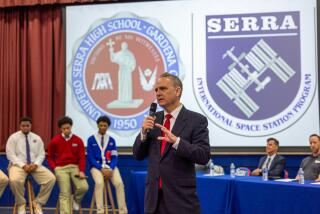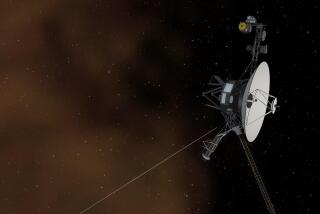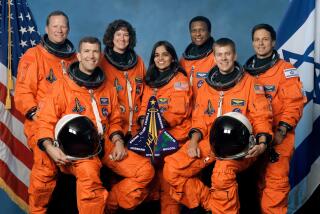COSTA MESA : Students Get Brief Link With Shuttle
Students at Kline School got a lesson in perseverance and the sometimes capricious nature of technology Friday when their experimental linkup with the Space Shuttle Columbia dissolved into static.
The students briefly achieved two-way radio contact with the shuttle via an elaborate satellite “telebridge” that involved ground-control stations in Costa Mesa, Hawaii, Chicago and at the Johnson Space Center in Houston. The fragile radio link was broken when Hawaii lost contact with Columbia shortly after noon.
K.D. (Doug) Borcoman, an amateur radio enthusiast who initiated the experiment, said it was “a little bit disappointing” when the conversation with astronaut Donald A. Thomas was cut short. But Borcoman was heartened that the students will get another chance on Tuesday morning to ask Thomas about life in outer space.
“We just have to persevere,” said Borcoman, a philosophy logic instructor at Rancho Santiago College and the parent of a student at Kline School. “They’ll schedule us for a really good orbit next time.”
He said radio contact failed because the Columbia was too low on the horizon in relation to the control station in Hawaii and because an antenna on the shuttle was pointed in the wrong direction.
“When you consider the complexity of this, there are so many things that can go wrong,” said Borcoman, a 43-year-old Newport Beach resident. “We’ll try it again. I think everybody’s having a good time participating.”
During the brief contact between the students and the space shuttle, Thomas thanked the youths for sending him a T-shirt they designed for the SAREX (Shuttle Amateur Radio EXperiment) program.
Then student Blake Maxwell, a 9-year-old from Newport Beach, donned a headset and asked Thomas about temperature conditions inside the Columbia. There was no reply.
“I was really pumped up,” Maxwell said about trying to make contact with Thomas, a mission specialist. “I really want to find out the answer.”
Kline, a private school with 45 students ages 5 through 12, was the only school in California, and one of only 13 worldwide, that was given permission to link up with the astronauts.
Kline applied for the SAREX program 14 months ago. For the past eight weeks, students have been learning about space flight and high-tech communications. They went on a guided tour of the Jet Propulsion Laboratory in Pasadena, where they watched Columbia’s blast off on a huge TV screen July 8.
The shuttle is on a two-week mission to study the development of aquatic animals and cells.
When the students attempt to contact Columbia next week, they will be ready with some highly technical questions about genetic mapping of nematodes; swimming patterns of goldfish lacking gravity-sensing inner ear organs; and growth rates of plant seedlings in a weightless environment.
The radio contact with Columbia will coincide with the 25th anniversary of the Apollo 11 moon landing mission.
More to Read
Sign up for Essential California
The most important California stories and recommendations in your inbox every morning.
You may occasionally receive promotional content from the Los Angeles Times.










